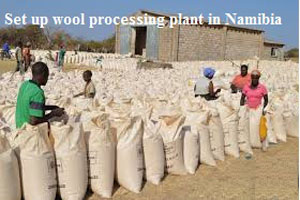
Plans to set up wool processing plant in Namibia
YarnsandFibers News Bureau 2016-09-11 12:00:00 – AfricaThe industrialization ministry and the Swakara Board of Namibia plan to commission a feasibility study on the setting up of wool processing plant in Namibia which could process as much as 360 000 tonnes of wool. The study is expected to cover wool processing such as grading, scouring, drying, carding and felting.
The study will also determine the number of Swakara sheep, and a minimum acceptable farm-gate price for raw wool in Namibia comparative in southern Africa, amongst other things.
The study is expected to identify the market for 360 000 tonnes of wool and its selling price in the local and export markets, and the packaging thereof.
The project is in line with the 'Growth at Home' strategy, which is Namibia's execution strategy for industrialization. The trade ministry has commissioned the development of a sector growth strategy for the Swakara wool industry and its associated value chains. The need for an industrial processing plant was highlighted as one of the keys to the growth of the industry.
The study is expected to be carried out within a period of 45 days spread over the time from the signing of the contract on 24 October to 31 January 2017 when the feasibility study report must be submitted.
At the moment, the Swakara Board of Namibia governs the Swakara industry in Namibia. Agra, by agreement with the board, is the sole sorting and marketing agent of Swakara pelts. Copenhagen Fur is the largest fur auction house in the world where Swakara pelts are sold on auction bi-annually.
In collaboration with Kopenhagen Fur, Denmark, the Swakara Board promotes and sells Swakara pelts to the worldwide fur industry. China is currently the biggest end-user market for furs in the world.
The turnover for Swakara pelts realised was N$55,4 million for the period, compared to N$73,9 million for 2014.
According to the 2015 Agra annual report, pelt quantities sold at the two auctions in Copenhagen during September 2014 and April 2015 amounted to108 706 pelts, which reflected a decrease of 12%, compared to 123 462 pelts sold during the year ending July 2014.
According to the ministry, the purpose of the sector growth strategy is to define concrete plans aimed at improving domestic value addition, and the upgrading of manufacturing capacities to generate growth and employment in the industry.
Market Intelligence
Ask for free sample Report

experience
Customer Base
dedicated team
Countries Served Worldwide









